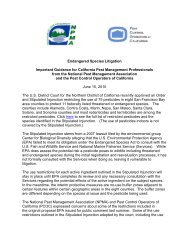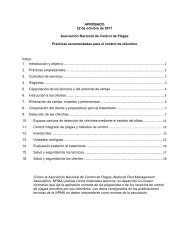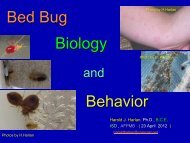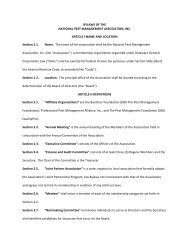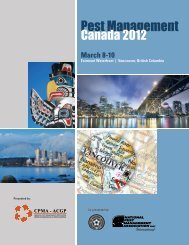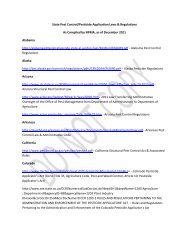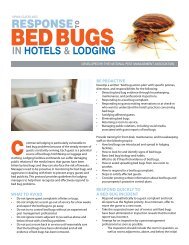HUD Notice H 2011-20
HUD Notice H 2011-20
HUD Notice H 2011-20
Create successful ePaper yourself
Turn your PDF publications into a flip-book with our unique Google optimized e-Paper software.
2III. ApplicabilityThis <strong>Notice</strong> is applicable to all Multifamily properties with active <strong>HUD</strong> Insured,<strong>HUD</strong>-Held or Direct Loans, Section <strong>20</strong>2 or 811 Capital Advances, Project-Based RentalAssistance contracts, and/or <strong>HUD</strong> Use Agreements.IV. Prevention of Bed Bug InfestationsThe best approach to bed bug management is to prevent an infestation fromoccurring in the first place. Federal agencies, such as EPA and <strong>HUD</strong>, are working intandem to develop and share recommendations to prevent bed bug infestations.O/As are strongly encouraged to develop an Integrated Pest Management (IPM)Plan. Such plans describe the ongoing efforts the property management will take toprevent and respond to pests. For more detail on IPM, please see the online guide athttp://www.stoppests.org. According to the EPA, principles of IPM for bed bugs include:Raising awareness through education on prevention of bed bugs;Inspecting infested areas, plus surrounding living spaces;Checking for bed bugs on luggage and clothes when returning home from a trip;Looking for bed bugs or signs of infestation on secondhand items before bringingthe items home;Correctly identifying the pest;Keeping records – including dates when and locations where pests are found;Cleaning all items within a bed bug infested living area;Reducing clutter where bed bugs can hide;Eliminating bed bug habitats;Physically removing bed bugs through cleaning;Using pesticides carefully according to the label directions; and,Following up on inspections and possible treatments.In addition or as part of an IPM, Multifamily O/As are strongly encouraged to takethe following preventive steps:Provide training for staff to identify bed bugs, and to perform ongoing preventionactions as outlined in the IPM. When a community is at high risk for bed bugs(for example, if the community has experienced prior infestations), periodicbuilding inspections are recommended.Actively engage residents in efforts to prevent bed bugs. Education andinvolvement of project residents is a critical component of IPM for bed bugs. Bedbugs may often go undetected and unreported, because they are active at night,and tenants may not be aware of their presence. O/As may wish to holdworkshops for tenants to learn to identify bed bugs, to create unfriendlyenvironments for pests, and to report suspicions of bed bugs as soon as possible.
3Provide orientation for new tenants and staff, and post signs and handouts.More information on bed bug prevention may be found by accessing the followingwebsites: 1Healthy Homes Training: What’s Working for Bed Bug Control in MultifamilyHousing?: Reconciling best practices with research and the realities ofimplementation.http://www.healthyhomestraining.org/ipm/NCHH_Bed_Bug_Control_2-12-10.pdf.National Pest Management Association Bed Bug Hub:http://pestworld.org/pest-world-blog/the-bed-bug-hub-one-stop-shop-for-bed-buginformationNational Pest Management Association Best Practices Website:http://www.bed bugbmps.orgEnvironmental Protection Agency:http://www.epa.gov/pesticides/bed bugs/V. Addressing InfestationsThe O/A should respond with urgency to any tenant report of bed bugs. Within24 hours of the tenant report, the O/A should make contact with the tenant, provide thetenant with information about bed bugs, and discuss measures the tenant may be able totake in the unit before the inspection is performed. However, a bed bug inspection and, ifnecessary, treatment, may take time to schedule. The O/A should endeavor to takeappropriate action within a reasonable time period using the guidelines provided below.Following a report of bed bugs, the O/A or a qualified third party trained in bed bugdetection should inspect the dwelling unit to determine if bed bugs are present. It iscritical that inspections be conducted by trained staff or third party professionals. Lowlevel inspections may escape visual detection. For this reason, multiple detection toolsare recommended. Recent research indicates that “active” bed bug monitors containingattractants can be effective tools for detecting early infestations. Some licensed pestcontrol applicators use canine detection to verify the presence of bed bugs. Theinspection should cover the unit reporting the infestation and no less than surroundingapartments consisting of the units above, below, left and right, and should be completedwithin 3 calendar days of a tenant complaint if possible. If reputable, licensed pestcontrol companies are unattainable within three calendar days, the O/A is required to1 An additional resource for interested parties is the Bed Bug Handbook. L.J. Pinto, R. Cooper, and S.K.Kraft, Bed Bug Handbook: The Complete Guide to Bed Bugs and Their Control (Mechanicsville, MD: S.K.Pinto & Associates, <strong>20</strong>07).
4retain documentation of the efforts to obtain qualified services. If an infestation issuspected but cannot be verified using the methods described above, the O/A shouldre-inspect the unit(s) periodically over the next several months.When an infestation is identified, the unit and surrounding units should be treatedfor bed bugs according to the IPM Plan. Chemical treatments may be necessary, but arenot reliable. Therefore, encasement, interception devices, vacuuming, steaming, freezingand commodity or building heat treatments may be utilized as part of the bed bug controleffort. Infestations are rarely controlled in one visit. Effective treatment may require twoto three visits, and possibly more. The length, method and extent of the treatment willdepend on the severity and complexity of the infestation, and the level of cooperation ofthe residents.An O/A may contact <strong>HUD</strong> to request financial resources for bed bug control. TheHub/PC Director may honor requests for releases from the Reserve for Replacement orResidual Receipts accounts to reimburse an Owner for bed bug treatment. The releasesshould follow the processes outlined in <strong>HUD</strong> Handbook 4350.1, Multifamily ProjectServicing, Chapters 4 and 25. Owners should be encouraged to make advances (loanwithout interest) when no reserves are available. <strong>HUD</strong> may also consider an increasedpest control line item in the project’s operating budget, if the Section 8 HousingAssistance Payments (HAP) contract allows for budget-based rent setting in accordancewith the Section 8 Renewal Policy Guide. However, any request for a rent increaseshould be part of an ongoing pest prevention program.VI. Recurring InfestationsMany properties are facing recurring infestations. O/As may offer protective toolsto residents to help safeguard properties from recurrences. For example, the O/A mayoffer residents bed covers, climb-up interceptors, or other detection or protection devicesthat may become available. O/As may voluntarily offer to inspect tenants’ furniturebefore move-in. O/As may require the non-chemical treatment of furniture upon tenantmove-in, and may offer, but may not require, non-chemical treatment or inspection ofused furniture and/or non-chemical treatment of luggage before it is unpacked when atenant returns from a trip. Tenants may voluntarily use such services. These services orproducts are to be offered at the Owner’s expense.An O/A may not deny tenancy to a potential resident on the basis of the tenanthaving experienced a prior bed bug infestation, nor may an owner give residentialpreference to any tenant based on a response to a question regarding prior exposure tobed bugs. An Owner may not charge a tenant to cover the cost of bed bug treatment.Such costs should be covered by the Owner or from project funds authorized by <strong>HUD</strong> asdescribed above. <strong>HUD</strong> reserves the right to approve Lease Addenda. Lease Addendamay not conflict with this <strong>Notice</strong>.
5VII. Tenant Rights and ResponsibilitiesTenants are strongly encouraged to immediately report the suspicion of possible bedbugs in a housing unit or other areas of the property. Early reporting allows the pests tobe identified and treated before the infestation spreads. Tenants are the first line ofdefense against bed bug infestations and should be encouraged to create livingenvironments that deter bed bugs. This includes reducing unreasonable amounts ofclutter that creates hiding places for bed bugs, and regular checking of beds andlaundering of linens.Bed bug infestations can cause health concerns, including physical discomfort,stress and anxiety on the part of the residents. Tenants should be advised of thefollowing:An O/A may not deny tenancy to a potential resident on the basis of thetenant having experienced a prior bed bug infestation, nor may an ownergive residential preference to any tenant based on a response to a questionregarding prior exposure to bed bugs.A tenant reporting bed bugs may expect expeditious response andattention by the O/A, but should be advised that inspection and, ifnecessary, treatment of bed bugs may take time to schedule. Theinspections should occur within three calendar days of the tenant reportwhen possible.Following a tenant report of bed bugs, the O/A staff trained in bed bugidentification (or a third party pest control representative) may inspect anyunit in the property to independently verify the presence of bed bugs andto treat an infestation. The O/A may enter the unit to perform theseactivities, in accordance with the lease.If bed bug infestation is found in the unit, the tenant may expect treatmentto begin within five days of the inspection, though depending on the formof treatment, this may not be possible. Tenants should be advised thattreatment may take several weeks.Tenants are expected to cooperate with the treatment efforts by allowingfor heat treatment of clothing and furniture and refraining from placementof infested furniture or other items in common areas such as hallways.Tenant cooperation is shown to expedite the control of bed bugs and toprevent spreading of infestations.Management may make staff available to help with moving and cleaningof furniture to accomplish the treatment effort.The tenant will not be expected to contribute to the cost of the treatmenteffort.
6Generally, relocation from the unit is not necessary; bed bugs may causediscomfort but are not believed to carry disease. However, if reasonabletemporary relocation is necessary, the O/A may request withdrawals fromReserve for Replacement or Residual Receipts accounts as describedabove for those days when treatment is actively occurring that may renderthe unit uninhabitable. All withdrawals of this type must be approved bythe Hub/PC Director or designee. Any temporary relocation must becarried out in accordance with applicable civil rights laws, including, butnot limited to, Title VI of the Civil Right Act of 1964 and Section 504 ofthe Rehabilitation Act of 1973. For example, when persons withdisabilities are temporarily relocated, they must be placed in housing thatprovides, at a minimum, the same accessibility features as the housing inwhich they currently reside. Additionally, the O/A must ensure the rightof return for tenants who have had to be temporarily relocated while thebed bug treatment is being performed.The tenant will not be reimbursed the cost of any additional expense to thehousehold, such as purchase of new furniture, clothing or cleaningservices. However, the tenant may be reimbursed the cost of protectivebed covers, at the Owner’s discretion.VIII. Responding to Inspection FindingsBed bugs should be addressed when reported by staff, tenants or the Real EstateAssessment Center (REAC), or if an audit by the <strong>HUD</strong> Office of the Inspector Generalidentifies possible infestation.Presently, REAC inspectors will only deduct points if bed bugs are observed in anapartment or building. However, inspectors now ask the O/A to identify any units and/orbuildings that are infested before the inspection begins. If bed bugs are reported, theinspector will record the units and/or buildings affected in the comment section of thePhysical Inspection report.The REAC sends a “Bed Bugs Reported” email to the Hub/Program Center Directorwhen bed bugs are noted in the comments section of a Physical Inspection Report. TheOwner will see the information on the inspection report in the comment area.<strong>HUD</strong> staff must take the following steps upon receipt of the “Bed Bugs Reported”email from REAC, regardless of the score, or if bed bugs are cited as a deficiency withinthe REAC report or if bed bugs are reported by the O/A, project residents, thePerformance Based Contract Administrator, or an OIG audit:Enter the bed bug information on the Problem Statement screen in theIntegrated Real Estate Management System (iREMS).If bed bugs were identified by REAC, send the attached letter to theOwner regardless of the score of the REAC Physical Inspection.
7Advise the Owner to describe what actions were taken or will be taken toeradicate the infestation.Advise the Owner to inform <strong>HUD</strong> when the problem has been completelyeradicated.Consider releasing funds from Reserve for Replacement or ResidualReceipts accounts if requested.Continue to enter all related information into the Problem Statementscreen in iREMS; and,Report any significant developments or problems regarding a bed buginfestation to Headquarters, Office of Asset Management.Note: Bed bugs are a national problem, so the above action should be taken whenREAC notes the presence of bed bugs in the comments section of an inspection,and/or if bed bugs are cited as a deficiency within the body of the inspection report.If you have questions, please contact your Desk Officer in the Office of AssetManagement.Attachment/s/___________________________________Carol J. GalanteActing Assistant Secretary for Housing –Federal Housing Commissioner



